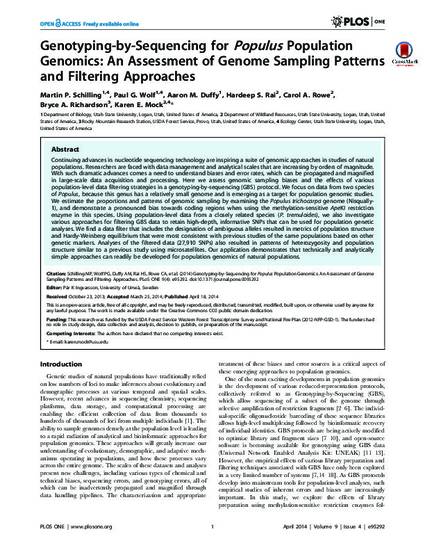
Continuing advances in nucleotide sequencing technology are inspiring a suite of genomic approaches in studies of natural populations. Researchers are faced with data management and analytical scales that are increasing by orders of magnitude. With such dramatic advances comes a need to understand biases and error rates, which can be propagated and magnified in large-scale data acquisition and processing. Here we assess genomic sampling biases and the effects of various population-level data filtering strategies in a genotyping-by-sequencing (GBS) protocol. We focus on data from two species of Populus, because this genus has a relatively small genome and is emerging as a target for population genomic studies. We estimate the proportions and patterns of genomic sampling by examining the Populus trichocarpa genome (Nisqually-1), and demonstrate a pronounced bias towards coding regions when using the methylation-sensitive ApeKI restriction enzyme in this species. Using population-level data from a closely related species (P. tremuloides), we also investigate various approaches for filtering GBS data to retain high-depth, informative SNPs that can be used for population genetic analyses. We find a data filter that includes the designation of ambiguous alleles resulted in metrics of population structure and Hardy-Weinberg equilibrium that were most consistent with previous studies of the same populations based on other genetic markers. Analyses of the filtered data (27,910 SNPs) also resulted in patterns of heterozygosity and population structure similar to a previous study using microsatellites. Our application demonstrates that technically and analytically simple approaches can readily be developed for population genomics of natural populations.
Paul G. Wolf https://orcid.org/0000-0002-4317-6976
Aaron M. Duffy https://orcid.org/0000-0003-0530-6191
Schilling, M.P., Wolf, P.G., Duffy, A.M., Rai, H.S., Rowe, C.A., Richardson, B.A., Mock, K.E. Genotyping-by-sequencing for Populus population genomics: An assessment of genome sampling patterns and filtering approaches (2014) PLoS ONE, 9 (4), art. no. e95292. Available at 10.1371/journal.pone.0095292
